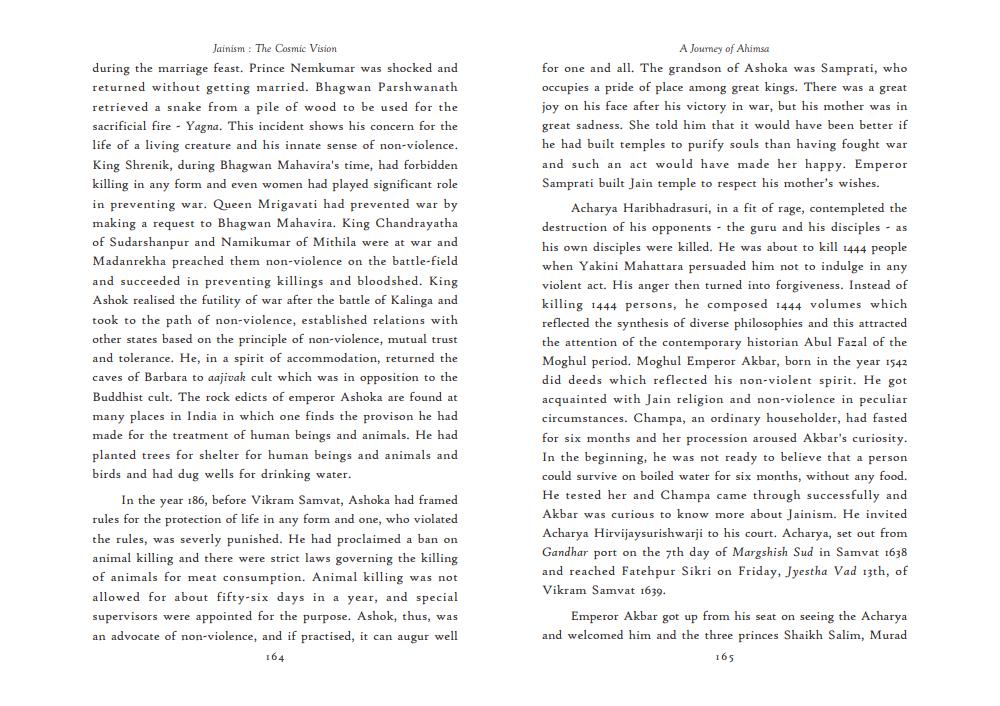________________
Jainism: The Cosmic Vision during the marriage feast. Prince Nemkumar was shocked and returned without getting married. Bhagwan Parshwanath retrieved a snake from a pile of wood to be used for the sacrificial fire - Yagna. This incident shows his concern for the life of a living creature and his innate sense of non-violence. King Shrenik, during Bhagwan Mahavira's time, had forbidden killing in any form and even women had played significant role in preventing war. Queen Mrigavati had prevented war by making a request to Bhagwan Mahavira, King Chandrayatha of Sudarshanpur and Namikumar of Mithila were at war and Madanrekha preached them non-violence on the battle-field and succeeded in preventing killings and bloodshed. King Ashok realised the futility of war after the battle of Kalinga and took to the path of non-violence, established relations with other states based on the principle of non-violence, mutual trust and tolerance. He, in a spirit of accommodation, returned the caves of Barbara to aajivak cult which was in opposition to the Buddhist cult. The rock edicts of emperor Ashoka are found at many places in India in which one finds the provison he had made for the treatment of human beings and animals. He had planted trees for shelter for human beings and animals and birds and had dug wells for drinking water.
In the year 186, before Vikram Samvat, Ashoka had framed rules for the protection of life in any form and one, who violated the rules, was severly punished. He had proclaimed a ban on animal killing and there were strict laws governing the killing of animals for meat consumption. Animal killing was not allowed for about fifty-six days in a year, and special supervisors were appointed for the purpose. Ashok, thus, was an advocate of non-violence, and if practised, it can augur well
164
A Journey of Ahimsa for one and all. The grandson of Ashoka was Samprati, who occupies a pride of place among great kings. There was a great joy on his face after his victory in war, but his mother was in great sadness. She told him that it would have been better if he had built temples to purify souls than having fought war and such an act would have made her happy. Emperor Samprati built Jain temple to respect his mother's wishes.
Acharya Haribhadrasuri, in a fit of rage, contempleted the destruction of his opponents - the guru and his disciples - as his own disciples were killed. He was about to kill 1444 people when Yakini Mahattara persuaded him not to indulge in any violent act. His anger then turned into forgiveness. Instead of killing 1444 persons, he composed 1444 volumes which reflected the synthesis of diverse philosophies and this attracted the attention of the contemporary historian Abul Fazal of the Moghul period. Moghul Emperor Akbar, born in the year 1542 did deeds which reflected his non-violent spirit. He got acquainted with Jain religion and non-violence in peculiar circumstances. Champa, an ordinary householder, had fasted for six months and her procession aroused Akbar's curiosity. In the beginning, he was not ready to believe that a person could survive on boiled water for six months, without any food. He tested her and Champa came through successfully and Akbar was curious to know more about Jainism. He invited Acharya Hirvijaysurishwarji to his court. Acharya, set out from Gandhar port on the 7th day of Margshish Sud in Samvat 1638 and reached Fatehpur Sikri on Friday, Jyestha Vad 13th, of Vikram Samvat 1639.
Emperor Akbar got up from his seat on seeing the Acharya and welcomed him and the three princes Shaikh Salim, Murad
165




